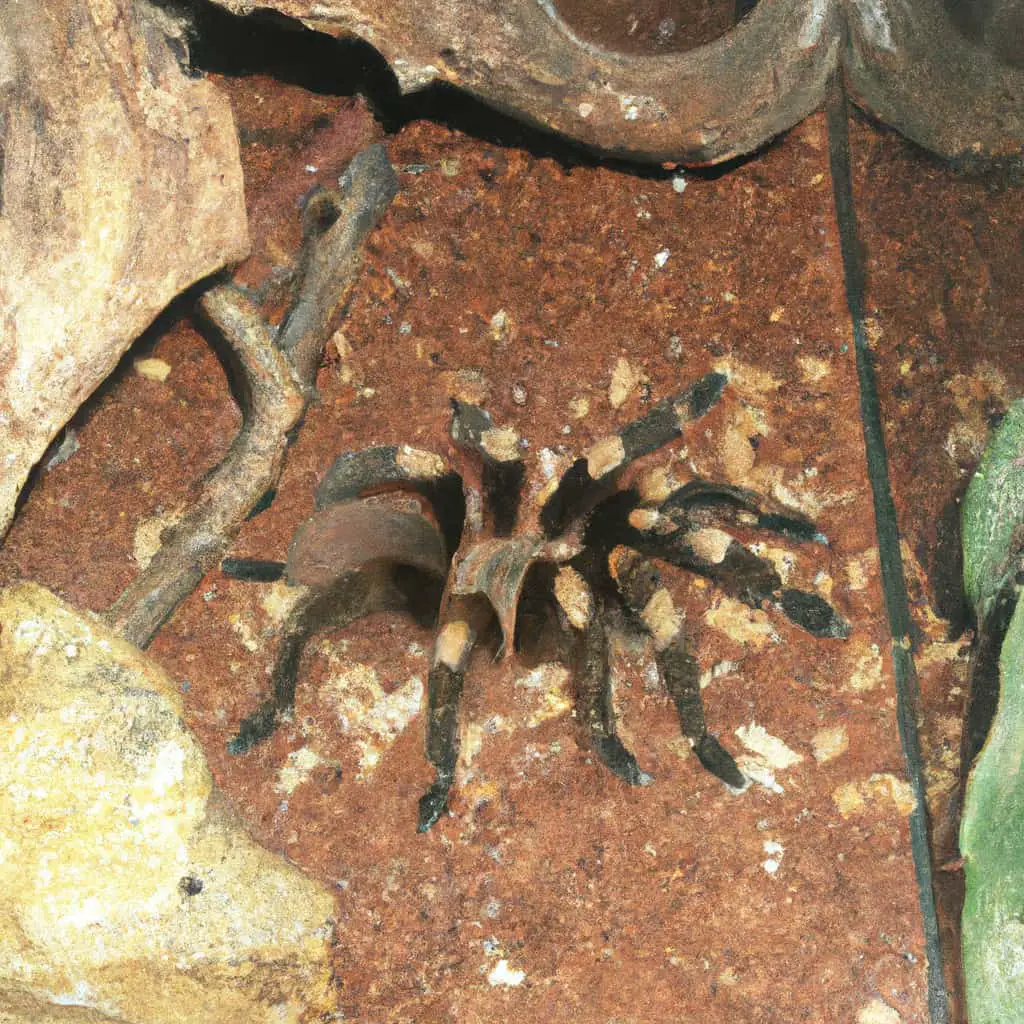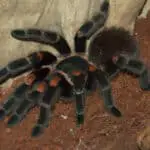Cleaning a tarantula enclosure may seem like a daunting task, but it’s an important part of keeping your spider healthy and happy. As a tarantula owner, I’ve learned the importance of routine cleaning and maintenance to prevent mold, bacteria, and other harmful substances from accumulating in the enclosure. In this article, I’ll share my tips and tricks for cleaning a tarantula enclosure, from choosing the right materials to preventing and dealing with mold.
Understanding the tarantula enclosure is the first step in proper cleaning and maintenance. Tarantulas require a clean and spacious environment to thrive, and their enclosure should mimic their natural habitat as much as possible. Choosing the right materials for the substrate, decor, and water dish is crucial to creating a safe and healthy living space for your spider. In this article, I’ll provide guidance on selecting the best materials for your tarantula’s enclosure and explain how to properly clean and maintain them.
Key Takeaways
- Regular cleaning and maintenance of a tarantula enclosure is crucial for the spider’s health and well-being.
- Choosing the right materials for the substrate, decor, and water dish is essential for creating a safe and healthy living space for your tarantula.
- Preventing and dealing with mold is an important part of tarantula enclosure hygiene.

Understanding Tarantula Enclosure
As a tarantula keeper, it is important to understand the housing requirements of your pet. Tarantulas are fascinating creatures that require a specific type of enclosure to thrive in captivity. In this section, I will discuss the basics of tarantula enclosures, including their size, design, and necessary components.
Firstly, it is important to choose the right size enclosure for your tarantula. The size of the enclosure will depend on the size of your tarantula and its species. As a general rule, the enclosure should be at least three times the leg span of the tarantula in length and width. This will provide enough space for the tarantula to move around comfortably.
Secondly, the design of the enclosure is also important. Tarantulas are known to be excellent escape artists, so it is important to choose an enclosure that is secure and escape-proof. The enclosure should have a tight-fitting lid that is secured with clips or locks to prevent the tarantula from escaping. It is also important to choose an enclosure that is well-ventilated to ensure proper air circulation.
Thirdly, the components of the enclosure are also crucial. The substrate should be a material that can hold moisture, such as coconut fiber or peat moss. This will help maintain humidity levels in the enclosure. Additionally, it is important to provide hiding places for the tarantula, such as cork bark or artificial plants. These hiding places will provide a sense of security for the tarantula and help reduce stress.
In summary, understanding the basics of tarantula enclosures is crucial for providing a comfortable and safe habitat for your pet. By choosing the right size, design, and components for the enclosure, you can ensure that your tarantula will thrive in captivity.
Choosing the Right Materials
When it comes to cleaning tarantula enclosures, it’s important to choose the right materials. This ensures that your tarantula stays healthy and happy, and that the cleaning process is as easy and stress-free as possible. Here are some things to consider when selecting materials for your tarantula’s enclosure:
Selecting the Substrate
The substrate is the material that lines the bottom of your tarantula’s tank. There are many different types of substrate to choose from, including coconut fiber, peat moss, and vermiculite. When selecting a substrate, it’s important to consider the needs of your tarantula. For example, some species prefer a dry substrate, while others require a more humid environment. Additionally, some substrates can be harmful to your tarantula if ingested, so be sure to do your research before making a selection.
Choosing the Accessories
Accessories such as water dishes, bedding, and decorations are important for keeping your tarantula healthy and happy. When selecting accessories, it’s important to choose items that are appropriate for your tarantula’s size and species. For example, a small tarantula may not need a large water dish, while a larger species may require more space to move around. Additionally, be sure to choose accessories that are easy to clean and maintain.
Picking the Right Tank
When selecting a tank for your tarantula, there are a few things to consider. First, be sure to choose a tank that is appropriate for your tarantula’s size and species. Additionally, consider the material of the tank. Glass tanks are popular, but they can be heavy and difficult to move. Plastic tanks, such as Tupperware containers, are lightweight and easy to clean, but they may not be as durable as glass tanks. Finally, consider the ventilation of the tank. Tarantulas require good airflow to stay healthy, so be sure to choose a tank with adequate ventilation.
In summary, choosing the right materials for your tarantula’s enclosure is essential for keeping your pet healthy and happy. When selecting substrate, accessories, and tanks, be sure to consider your tarantula’s needs and preferences. With the right materials, cleaning your tarantula’s enclosure can be a stress-free and enjoyable experience.
Cleaning Basics
Cleaning your tarantula enclosure is an important part of caring for your pet spider. Keeping the enclosure clean and hygienic can prevent your spider from getting sick and ensure it has a comfortable living space. In this section, I will go over the basics of cleaning your tarantula enclosure, including spot cleaning and deep cleaning.
Spot Cleaning
Spot cleaning is the process of removing any visible waste or debris from your tarantula’s enclosure. You should perform spot cleaning daily to keep the enclosure clean and prevent any unpleasant odors from developing.
To spot clean your tarantula’s enclosure, you will need a pair of gloves, paper towels, and a catch cup. Start by removing any uneaten food or dead insects from the enclosure using the catch cup. Next, use the paper towels to remove any waste or debris from the substrate. Be careful not to disturb your tarantula during this process.
Once you have finished spot cleaning, you should also check the water dish and replace the water if necessary. Clean, fresh water is essential for your tarantula’s health and well-being.
Deep Cleaning
Deep cleaning is a more thorough cleaning process that should be performed every few months. During deep cleaning, you will remove all of the substrate from the enclosure and clean all of the surfaces.
To deep clean your tarantula’s enclosure, you will need a garbage bag, gloves, a cleaning scrubby brush or sponge, and new substrate. Start by removing your tarantula from the enclosure and placing it in a temporary container. Next, remove all of the substrate from the enclosure and dispose of it in the garbage bag.
Once the enclosure is empty, use the cleaning scrubby brush or sponge to clean all of the surfaces, including the walls and decorations. Rinse everything thoroughly with clean water and allow it to dry completely.
Once the enclosure is dry, add new substrate and replace any decorations or hiding places. Finally, return your tarantula to its clean and comfortable home.
Remember to always use clean water and avoid using any harsh chemicals or cleaners when cleaning your tarantula’s enclosure. With regular cleaning and care, your tarantula can live a healthy and happy life.
Maintaining Proper Hygiene
As a tarantula owner, it is important to maintain proper hygiene in your spider’s enclosure. This not only ensures a clean and healthy living environment for your spider but also prevents the spread of harmful bacteria and diseases.
One of the most important steps in maintaining proper hygiene is to spot clean your tarantula’s enclosure regularly. This involves removing any leftover food, feces, or shed skin from the enclosure. I usually do this every other day or as soon as I notice any buildup.
In addition to spot cleaning, it is important to deep clean your tarantula’s enclosure every 4-6 months. This involves removing all substrate, cleaning the enclosure with a mild soap and water solution, and allowing it to dry completely before adding fresh substrate.
When cleaning your tarantula’s enclosure, it is important to wear gloves to prevent the spread of any harmful bacteria. I also make sure to wash my hands thoroughly before and after handling my spider or cleaning its enclosure.
Another important aspect of maintaining proper hygiene is to clean your tarantula’s water dish regularly. This prevents the buildup of harmful bacteria and ensures that your spider has access to clean water. I usually change the water every day and clean the dish with a mild soap and water solution.
Overall, maintaining proper hygiene in your tarantula’s enclosure is essential for the health and well-being of your spider. By following these simple steps, you can ensure a clean and healthy living environment for your furry friend.
Rehousing Your Tarantula
When it’s time to clean your tarantula’s enclosure, you’ll need to rehouse your spider temporarily. This can be a bit nerve-wracking, but with the right approach, it’s a simple process.
First, you’ll need a catch cup or holding container to safely move your tarantula. These can be purchased at most pet stores or online. Make sure the container is large enough for your spider to comfortably fit inside.
Next, carefully remove any decorations or hiding spots from the enclosure. If you have a new tarantula, be extra cautious not to startle or stress your spider. Slowly and gently coax it into the catch cup using a soft brush or your hand.
Once your tarantula is safely in the container, cover it with a lid or mesh to prevent escape. Move the container to a safe and quiet location while you clean the enclosure.
After cleaning, reverse the process to move your tarantula back into its home. Take your time and be gentle. Your spider may be a bit disoriented or stressed, so give it some time to readjust to its environment.
Remember, rehousing your tarantula is an important part of maintaining a clean and healthy living space for your spider. With patience and care, you can safely move your spider without causing harm or stress.
Preventing and Dealing with Mold
As a tarantula owner, it is important to understand how to prevent and remove mold in your pet’s enclosure. Mold is a type of fungus that can grow in damp and humid environments, such as tarantula enclosures. It can be harmful to tarantulas, causing respiratory issues and potentially leading to death. In this section, I will discuss how to recognize mold and how to effectively remove it.
Recognizing Mold
Mold can appear in different forms, such as white or greenish spots, and can have a musty odor. It is important to regularly inspect your tarantula’s enclosure for any signs of mold growth. Additionally, mold growth can be caused by a variety of factors, including poor ventilation, excessive moisture, and improper substrate.
Removing Mold
If you notice mold in your tarantula’s enclosure, it is important to act quickly to prevent further growth. The first step is to remove your tarantula from the enclosure and place it in a temporary, clean container. Next, remove any moldy substrate, decorations, or other materials from the enclosure.
After removing the moldy materials, it is important to thoroughly clean and disinfect the enclosure. Use a chemical disinfectant that is safe for tarantulas and follow the instructions carefully. Once the enclosure is disinfected, allow it to air dry completely before adding new substrate and decorations.
To prevent mold growth in the future, make sure to provide proper ventilation in the enclosure and avoid over-moistening the substrate. Additionally, consider using springtails or soil mites in the substrate, as they can help prevent mold growth by eating fungi and mold spores.
In conclusion, mold growth in a tarantula’s enclosure can be harmful to your pet’s health and should be dealt with promptly. Regularly inspecting the enclosure for signs of mold and providing proper ventilation and substrate can help prevent mold growth. If mold is present, remove your tarantula from the enclosure, clean and disinfect the enclosure, and allow it to air dry completely before adding new substrate and decorations.
Feeding and Waste Management
When it comes to feeding your tarantula, it’s important to be mindful of waste management. Here are some tips to help keep your tarantula’s enclosure clean and healthy:
- Prey: Always provide your tarantula with appropriate prey items. Overfeeding can lead to excess waste and uneaten prey can attract pests.
- Food Waste: Remove uneaten prey items within 24 hours to prevent bacteria growth and odor.
- Exoskeleton: After molting, your tarantula will leave behind its exoskeleton. Leave it in the enclosure for a few days to allow your tarantula to consume it for added nutrition.
- Residual Food: Use tongs or tweezers to remove any residual food or prey items.
- Precautions: Always wash your hands before and after handling prey items or cleaning the enclosure to prevent contamination.
- Compost: Consider composting uneaten prey items and exoskeletons to reduce waste and provide nutrients for your plants.
- Prey Item: Avoid feeding your tarantula wild-caught insects as they may carry parasites or diseases.
- Feeding: Feed your tarantula in a separate container to prevent substrate contamination and to make it easier to remove uneaten prey items.
By following these tips, you can help maintain a clean and healthy environment for your tarantula.
Creating a Bioactive Enclosure
When it comes to tarantula enclosures, creating a bioactive environment can be beneficial for both the tarantula and the owner. A bioactive enclosure is a terrarium that is designed to mimic a tarantula’s natural environment as closely as possible. In this section, I will discuss some of the key elements of creating a bioactive enclosure.
Environmental Conditions
One of the most important aspects of creating a bioactive enclosure is to ensure that the environmental conditions are suitable for your tarantula. This includes factors such as temperature, humidity, and lighting. Tarantulas generally prefer a warm and humid environment, so it is important to maintain a temperature range of 75-85°F and a humidity level of around 70-80%.
Terrarium
The first step in creating a bioactive enclosure is to choose an appropriate terrarium. The size of the terrarium will depend on the size of your tarantula. A good rule of thumb is to choose a terrarium that is at least three times the leg span of your tarantula. The terrarium should also have adequate ventilation to ensure that the air is circulating properly.
Plants
Adding live plants to your bioactive enclosure can provide a number of benefits. Plants can help to regulate humidity levels, absorb excess moisture, and provide a natural hiding place for your tarantula. Some good plant options for a bioactive enclosure include spider plants, pothos, and bromeliads.
Clean-up Crew
A key component of a bioactive enclosure is the use of a clean-up crew. This includes organisms such as springtails and isopods, which help to break down waste and keep the enclosure clean. It is important to ensure that the clean-up crew is properly established before adding your tarantula to the enclosure.
High Humidity
Maintaining high humidity levels in a bioactive enclosure can be challenging, but it is essential for the health of your tarantula. One way to increase humidity levels is to add a water dish to the enclosure. You can also mist the enclosure with water to maintain humidity levels.
Community
Creating a bioactive enclosure can be a fun and rewarding experience, but it is important to remember that not all tarantulas will thrive in this type of environment. It is important to do your research and choose a tarantula species that is well-suited to a bioactive enclosure. Joining a community of tarantula enthusiasts can also be a great way to learn more about creating a bioactive environment for your tarantula.
Final Considerations
Cleaning a tarantula enclosure is not a difficult task, but it is important to do it correctly. Here are a few final considerations to keep in mind:
- Routine cleaning is essential to maintain a healthy environment for your pet tarantula. Make sure to clean the enclosure at least once a month.
- Always use fresh water to rinse the enclosure and accessories after cleaning. Do not reuse water from previous cleanings.
- Use a scrubby brush to remove any dirt or debris from the enclosure. Do not use toxic cleaning products or dish soap.
- Vermiculite is a popular substrate for tarantula enclosures, but it can harbor mites. Make sure to replace vermiculite regularly.
- Lighting is not necessary for tarantulas, but it can help you see inside the enclosure during cleaning.
- Insects should be removed from the enclosure as soon as possible to avoid contamination.
- If your tarantula is molting, do not disturb it. Wait until the molting process is complete before cleaning the enclosure.
- If the enclosure is too large to fit in the sink, you can use a shower or a large garbage bag to clean it.
- Make sure to adjust the temperature in the room to keep your tarantula comfortable during cleaning.
- Finally, always keep the design of the enclosure in mind. Avoid disrupting any hiding places or decorations that your tarantula enjoys.
With these final considerations in mind, you can ensure that your tarantula has a clean and healthy home.
Frequently Asked Questions
How often should I clean my tarantula’s enclosure?
It is recommended to deep clean your tarantula’s enclosure every four to five months. However, it is important to make a habit of sanitizing their enclosures every eight weeks to keep them healthy and happy.
What is the best way to clean a tarantula enclosure?
The best way to clean a tarantula enclosure is to remove your tarantula from the enclosure and then remove all the substrate, decorations, and water dish. After that, wash everything with hot water and let it dry completely. You can also use a reptile-safe disinfectant to sanitize the enclosure.
Can I use soap to clean a tarantula enclosure?
No, you should not use soap to clean a tarantula enclosure. Tarantulas are sensitive to chemicals, and soap can leave behind residue that can harm your pet. Hot water and a reptile-safe disinfectant are the best options for cleaning a tarantula enclosure.
Should I remove my tarantula before cleaning its enclosure?
Yes, it is important to remove your tarantula from its enclosure before cleaning. This will prevent your tarantula from getting stressed or injured during the cleaning process. You can place your tarantula in a temporary container while you clean its enclosure.
What should I use to disinfect a tarantula enclosure?
You can use a reptile-safe disinfectant to sanitize a tarantula enclosure. Make sure to follow the instructions on the disinfectant and rinse everything thoroughly with hot water before returning your tarantula to its enclosure.
How often should I replace the substrate in my tarantula’s enclosure?
You should replace the substrate in your tarantula’s enclosure every three to four months. However, if your tarantula produces a lot of waste or if you notice any mold or mites in the enclosure, you should replace the substrate immediately.








